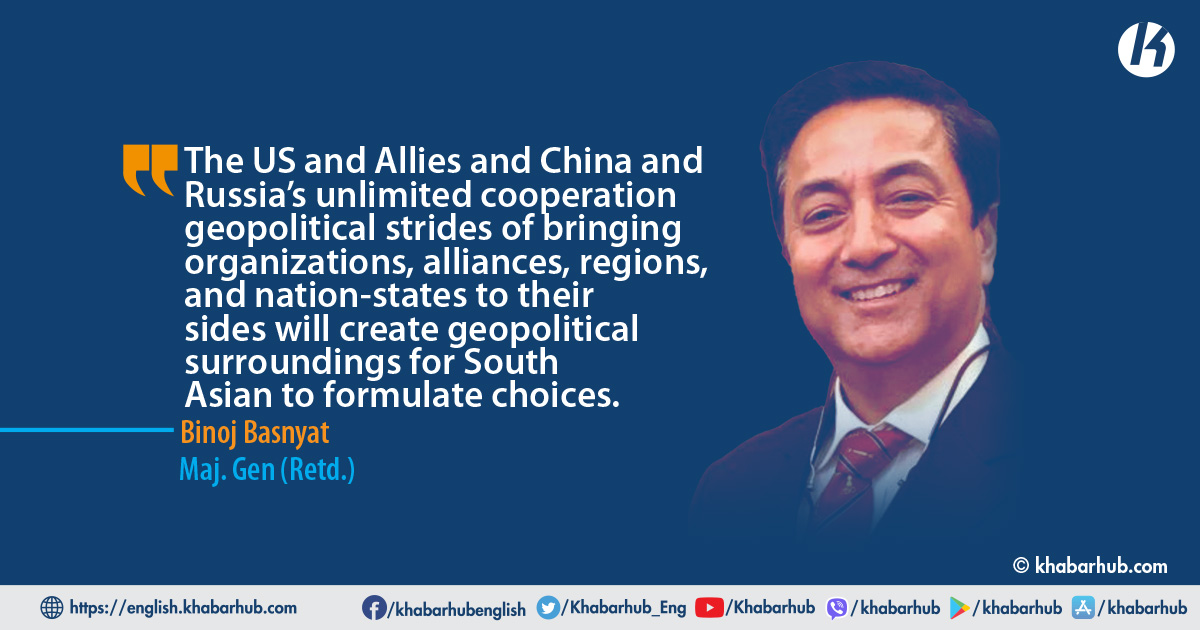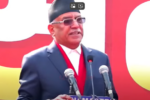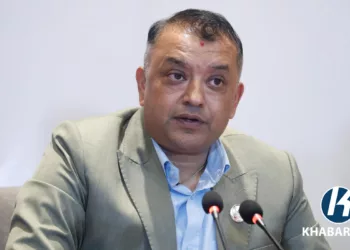The major western powers are focused on taming Russian President Putin, which can be illustrated as the continuation of the Cold War along with unsure on how to deal with China a commencing of a new Cold War or Cold War 2.0.
President Zelensky has been receiving support including military assets throughout, though eastern Ukraine is falling in the hands of Putin with millions migrating.
Russian gas supply has resumed delivering 40 percent of its capacity with a cautionary that the recommencement of gas was an indication that tensions were easing.
China and Russia the emerging and revisionist great powers respectively, are in confrontation with the superpower the US and the Allies. The US is getting hold of partners while China and Russia are behindhand.
The US and Allies and China and Russia’s unlimited cooperation in geopolitical strides of bringing organizations, alliances, regions, and nation-states to their sides will create geopolitical surroundings for South Asian to formulate choices.
Amid the Russian-Ukrainian war, the last few months have been witnessing a series of summits, meetings and telephonic conversations among key global leaders.
Of these summits and strategic happenings of notable national leaders the G7, North Atlantic Treaty Organization (NATO) meeting in Europe, Brazil, Russia, India, China, South Africa (BRICS) in Beijing, along with the approaching Shanghai Cooperation Organization (SCO) and the G20 are consequential.
The rising disapproval of NATO by Beijing and Moscow conveys the catchphrase “common adjacent region” that appeared for the first time in the joint statement of February 4, which is in opposition to extra-regional forces undermining security and stability in the IPR and region of influence for both China and Russia and the priority is South Asia, Central Asia and East Asia.
The likelihood of a long war with spill-out inflation worldwide and an imminent food crisis gazes for a serious and intense headway of reforming economic groupings and restructuring the world order that will shoulder repercussions for decades to come with a premise of persistence of the world order versus configuration of a new order.
BRICS Approach and Expansion as a Non-Western Organisation
BRICS is positioned as an alternative to the US-led liberal world order. BRICS nations vary from G7 in two features, mainly in the population of 3 billion as opposed to the G7’s 987 million (including the EU) and GDP, where G7’s GDP is currently US$ 33.93 trillion and BRICS about US$ 23. 5 trillion.
Brazil is the only country that voted against Russia’s invasion of Ukraine at the UN while others abstained from condemning it.
The Head of the States and Governments summit was themed around ushering in a “new era” for global development.
China set the stage one, to tout its governance model and two, it has termed a bloc of emerging economies for promoting multilateral cooperation with ‘non-Western styles, forms and principles’ with one-quarter of the global economy and third a legacy of siding with the third world.
President Xi has called on the group to “reject Cold War mentality and bloc confrontation and to work together to build a global community of security for all”.
The Summit also has been a vehicle to expand the vision of a new global order by redefining the terms democracy and human rights.
The summit ended with seven declarations, Strengthening and Reforming Global Governance, Working in Solidarity to Combat COVID-19, Safeguarding Peace and Security, Promoting Economic Recovery, Expediting Implementation of the 2030 Agenda for Sustainable Development, Deepening People-to-People Exchanges, and lastly by Institutional Development
At the back of the birthday wishes by PM Modi to Dalai Lama, Himachal Chief Minister and Minister Meenakshi Lekhi’s appearances at the celebration in Dharamshala and an event in Delhi respectively, the Enforcement Directorate searches the offices of the Chinese company Vivo in India, the BRICS virtual summit of Foreign Ministers (FM) of China and India happened after three months calling for an early resolution of a complete disengagement resolving the border stand-off that began in April 2020 by perceiving “mutual respect, mutual sensitivity and mutual interests.
Wany Yi remarks on both sides to “strengthen coordination and cooperation and jointly promote more democratic international relations and fairer international order by maintaining communications and exchanges and effectively managed differences”.
The strongly worded statement by the Chinese MFA spokesperson Zhao Lijan said that the Indian side should fully recognize the anti-China separatist nature of the 14th Dalai Lama and abide by its commitment to China, speak and act prudently and stop using Tibet-related issues to interfere in China’s internal affairs”.
In a different geopolitical environment, the leaders are clearly divided into two geopolitical state of affairs one on finding a different model to western values, systems of governance and development while the western nations were concerned with demonstrating unity against Russia and Putin’s war of aggression against Ukraine as well as a threat of China’s emergence as a global power.
Besides China and India’s competition, for the first time, FMs of Argentina, Egypt, Indonesia, Kazakhstan, Nigeria, the United Arab Emirates, Saudi Arabia, Senegal and Thailand were present also described as BRICS Plus intended for BRICS expansion.
In the convoluted geopolitical milieu, with Beijing’s impression of being isolated, the Russian invasion in Ukraine rising economic decoupling between China and the US, BRICS is situated as a diplomatic vengeance by China to the revival of NATO and its growing interests and the increase in other multilateral mechanisms that are keeping Beijing at check-in the Indo-Pacific region (IPR).
The after-effect of a probable Modi-Xi meeting in both the SCO and G20 will be of anxieties to the South Asian nations and the Himalayan region.
Strengthening NATO and the G7 in the IPR
NATO’s engagement for the first time with Australia, Japan, New Zealand and South Korea, with new partnerships like QUAD and AUKUS, is an expansion of the interests of western powers in the IPR.
Weeks before the Russian invasion of Ukraine, China and Russia have promised an “unlimited” and “non-banned area” strategic partnership directed against the west.
Russian offensive shifted the western flank of Moscow in search of NATO cover from neutrality like Finland and Sweden and the Central European nations’ suspicion with France and Germany are reluctant solely to bank on Europe’s way out and consider the US to maintain equilibrium for Russia
The first visit to Iran with meeting Iranian President, Supreme Leader Ayatollah Khamenei, and the Turkish President after the invasion by Putin is reaffirming the strategic ties.
Iran and Russia are military allies in the conflicts in Syria and partners in Afghanistan and post-Soviet Central Asia and form an axis in the Caucasus alongside Armenia and signed a US$ 40 billion agreement with new gas export pipelines and an expected supply of weapon-capable drones. National Security Council coordinator for strategic communications John Kirby said “Russia turning to Iran for help speaks volumes about the degree to which both nations, for their actions into different areas of the world, have been increasingly isolated by the international community”. Khamenei referring that the expansion of western security alliance NATO had to be stopped said that “NATO is a dangerous entity.
The West is opposed to a strong, independent Russia. If the way is opened for NATO, it will recognize no limits, if it hadn’t been stopped in Ukraine, it would have started a similar war in Crimea”. Raisi said, “world events show Iran and Russia’s need for increasing cooperation” and hailed a significant commitment to security cooperation with good experience in fighting terrorism. Russia is seeking support from nations that stand against the current American order.
However, the small nations of South Asia feel anxiety and indignation and that the interests of large nations may alter knocking their borders too not just by India but China’s influence in South Asia. International principles and law will be put aside and the interests of large nations will prevail like Russia, one of the P5 assert that Ukraine cannot survive and Moscow ought to have a veto over its actions.
Despite growing ties, China and Russia are not ‘Allies’ and China is not contributing militarily to the Russian Forces to elucidate a high degree of strategic autonomy.
The rising disapproval of NATO by Beijing and Moscow conveys the catchphrase “common adjacent region” that appeared for the first time in the joint statement of February 4, which is in opposition to extra-regional forces undermining security and stability in the IPR and region of influence for both China and Russia and the priority is South Asia, Central Asia and East Asia.
China was not revealed in the 2010 strategic concept but the strategic doctrine also agreed to find Russia as a partner.
But today you can distinguish that the world order is shifting as NATO declared Russia “the most important and direct threat to the security of its allies and the peace and stability of the Euro-Atlantic region”.
IPR is equivalently imperative for the IPR is that China was not ignored and declared that China’s “expressed ambitions and compulsory policies challenge our interests, security and values”.
Conclusion
In a different geopolitical environment, the leaders are clearly divided into two geopolitical state of affairs one on finding a different model to western values, systems of governance and development while the western nations were concerned with demonstrating unity against Russia and Putin’s war of aggression against Ukraine as well as a threat of China’s emergence as a global power.
In an interview with the Economic magazine in Nov 2019 French President Macron “what we are currently experiencing is the brain death of NATO” and President Donald Trump’s desire to shut NATO.
Germany is raising its defense spending when the political and commercial relationship with Russia was expediating. Finland and Sweden changed their neutral stand to be part of NATO.
The US military commitment has doubled to Europe. Asia and Europe saw an upsurge in reconciliation and affluence in Chinese and Russian influence in the last few decades and South Asia is no different but personal and ultra-nationalist ambitions have severe effects generating a geopolitical repercussions.
With no denial that Japan and South Korea are China’s decisive East Asian neighbors with built-up cultural, civilized and commercial ties, while Australia and New Zealand are interconnected to the Chinese economy but then again, all four are supporters of the Chinese led 15 member countries Regional Comprehensive Economic Partnership (RCEP) the first free trade agreement among the largest economies in Asia and now for the first time are part of the NATO meetings.
This again suggests Beijing’s influence and interference that is showing the way to its neighbors to NATO and other alliances.
Though on similar thoughts, China and Russia were in dissimilar domains throughout the Cold War due to China’s growing domestic and economic interests for nationwide stability and prosperity.
Expanding security relations for nation states in the IPR with further commitment through QUAD like Build Back the Better World, Partnership for Global Infrastructure and Investment and developing profound institutional military relations with NATO and AUKUS which has been a priority for some of Beijing’s neighbors.
This will assist intergovernmental Organisations SAARC, BIMSTEC, and ASEAN alike to improve Nation States’ deterrence against China’s interference in the long term.
South Asia is divided with large nations and middle powers on one side and small nations on the opposition. India is strategically balancing the old Russian friends for inexpensive energy support and the dependence on defense capabilities while establishing partners with the west fortifying its future.
Though the small states in Europe assessed that the sovereignty and territorial integrity had arrived in a new era, the European strategic environment similar to 1935 is once more threatening their borders.
In Europe, it is small European countries worried about losing territorial and political independence to Russia as the history of European international affairs was primarily about the rule of small nations by stronger nations with imperial ambitions.
The Harvard Belfer Centre for Science and International Affairs derived that, in 12 of 16 cases over the last 500 years in which there was a hasty alteration in the comparative power of a rising nation that threatened to dislodge a ruling state, the outcome was war.
However, the small nations of South Asia feel anxiety and indignation and that the interests of large nations may alter knocking their borders too not just by India but China’s influence in South Asia. International principles and law will be put aside and the interests of large nations will prevail like Russia, one of the P5 assert that Ukraine cannot survive and Moscow ought to have a veto over its actions.
This has stirred Europe now from its unwarranted imaginings but counseled the small and weak nations of the world.
Modi has been talking about the dangers of “expansionism” which India has been facing from China from 2014 onwards, in 2017, and on-going from 2020.
But PM Modi in a surprise visit to Ladakh in July 2020 said “The age of expansionism is over. This is the age of development. In the centuries gone by, it was expansionism that hurt humanity the most and sought to destroy it. Those who are driven by expansionism have always posed danger to the world.
History bears testimony that such forces have either been destroyed or been forced to turn back. It is due to this experience that the world coming together against expansionism forces”.
As Europe remains a priority for NATO, it is not incomprehensible to figure out because Asian countries are looking to NATO. It can also be reasoned that India’s growing prominence in QUAD is why China has acted against the disputed boundary.
China and Russian theory of expansionism will fetch strategic amalgamation of European and Asian geopolitical theatres. As Europe is dealing today Asian and with no exceptions South Asian will need to deal with the limited choices available in the future.
The Harvard Belfer Centre for Science and International Affairs derived that, in 12 of 16 cases over the last 500 years in which there was a hasty alteration in the comparative power of a rising nation that threatened to dislodge a ruling state, the outcome was war.
The scruffle for domination in Europe and Asia preceding half a millennium bids a succession of variations on common storylines.
(Basnyat is a strategic Analyst and a Maj. Gen. (Redt.), Nepali Army)









Comment